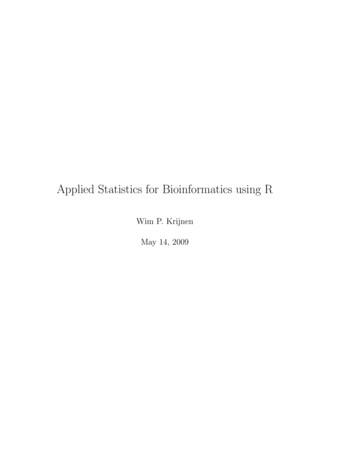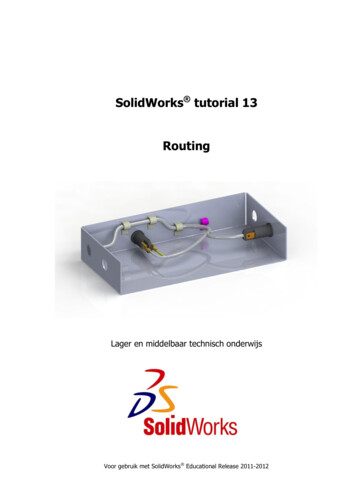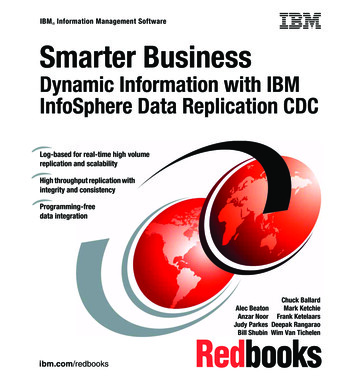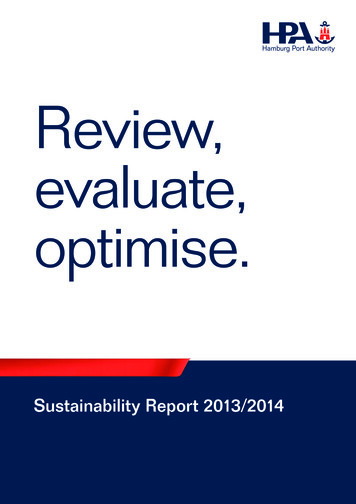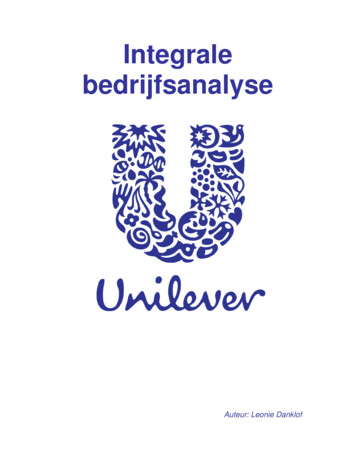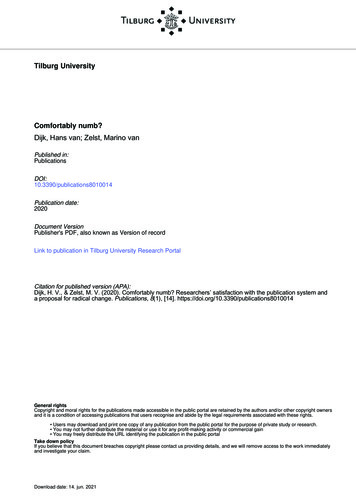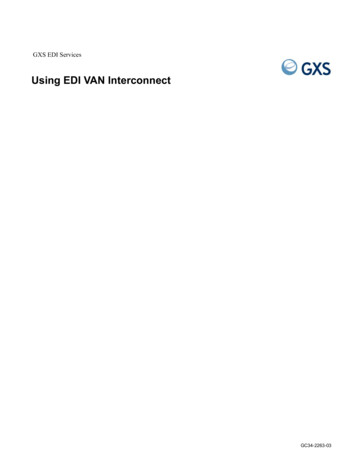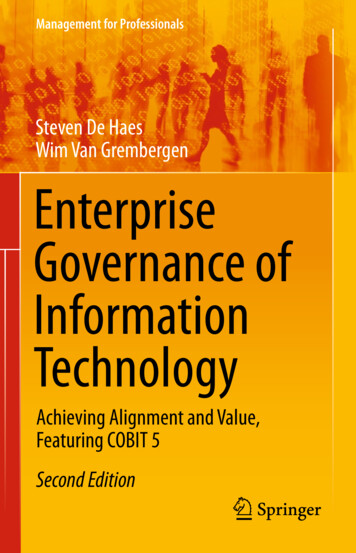
Transcription
Management for ProfessionalsSteven De HaesWim Van GrembergenEnterpriseGovernance ofInformationTechnologyAchieving Alignment and Value,Featuring COBIT 5Second Edition
Management for ProfessionalsMore information about this series at http://www.springer.com/series/10101
Steven De Haes Wim Van GrembergenEnterprise Governanceof Information TechnologyAchieving Alignment and Value,Featuring COBIT 5Second Edition
Steven De HaesInformation Technology Alignmentand Governance Research InstituteUniversity of Antwerp - AntwerpManagement SchoolAntwerp, BelgiumWim Van GrembergenInformation Technology Alignmentand Governance Research InstituteUniversity of Antwerp - AntwerpManagement SchoolAntwerp, BelgiumISSN 2192-8096ISSN 2192-810X (electronic)Management for ProfessionalsISBN 978-3-319-14546-4ISBN 978-3-319-14547-1 (eBook)DOI 10.1007/978-3-319-14547-1Library of Congress Control Number: 2015932080Springer Cham Heidelberg New York Dordrecht London Springer Science Business Media, LLC 2009 Springer International Publishing Switzerland 2015This work is subject to copyright. All rights are reserved by the Publisher, whether the whole or part ofthe material is concerned, specifically the rights of translation, reprinting, reuse of illustrations, recitation,broadcasting, reproduction on microfilms or in any other physical way, and transmission or informationstorage and retrieval, electronic adaptation, computer software, or by similar or dissimilar methodologynow known or hereafter developed.The use of general descriptive names, registered names, trademarks, service marks, etc. in this publicationdoes not imply, even in the absence of a specific statement, that such names are exempt from the relevantprotective laws and regulations and therefore free for general use.The publisher, the authors and the editors are safe to assume that the advice and information in this bookare believed to be true and accurate at the date of publication. Neither the publisher nor the authors or theeditors give a warranty, express or implied, with respect to the material contained herein or for any errorsor omissions that may have been made.Printed on acid-free paperSpringer International Publishing AG Switzerland is part of Springer Science Business Media(www.springer.com)
Preface“Enterprise Governance of IT” is a relatively new concept in the literature and isgaining more and more interest in the academic and practitioner’s world. “EnterpriseGovernance of IT” is about defining and embedding processes and structures in theorganization that enable both business and IT people to execute their responsibilities in creating value from IT-enabled business investments. As an example of itsgrowing importance, the standardization organization ISO issued in 2008 a newworldwide ISO standard in this domain.Within the University of Antwerp–Antwerp Management School–IT Alignmentand Governance (ITAG) Research Institute, we have been executing applied researchin this domain for many years now. With this book, we want to provide a completeand comprehensive overview of what Enterprise Governance of IT entails and howit can be applied in practice. Our conclusions in this book are based on our knowledge obtained in applied research projects, our many years of involvement in thedevelopment of COBIT, our own hands-on coaching and consulting experience inmany industries in governance and alignment projects, and international state-ofthe-art literature. In this way, this manuscript encompasses both academic modelsand concepts but also includes practice-oriented frameworks such as COBIT anddiscusses and analyzes many practical cases and examples in different industries.The target audience for this book is threefold: Master students, for whom this textbook can be used in courses typical on ITstrategy, Enterprise Governance of IT, IT management, IT processes, IT andbusiness architecture, IT assurance/audit, information systems management, etc. Executive students in business schools, for MBA type of courses where IT strategy or IT management modules are addressed. Practitioners in the field, both business and IT managers, who are seekingresearch-based fundamentals and practical implementation issues related to it inthe domain of Enterprise Governance of IT.This book is organized into seven main chapters. Chapter 1 defines the coreconcepts around Enterprise Governance of IT as a means to enable business/ITv
viPrefacealignment and business value from IT. This chapter sets the scene of the completebook. Chapter 2 builds on the first chapter and stipulates a conceptual model toaddress the challenge of implementing Enterprise Governance of IT in practice.This chapter also provides an overview of contemporary best practices organizations are using and addresses related topics on, for example, the role of the board ofdirectors in Enterprise Governance of IT and the context of interorganizational environments. In Chap. 3, the impact of Enterprise Governance of IT implementationson business/IT alignment is discussed. The first question is how an organization canmeasure and evaluate its current status of business/IT alignment. This discussion issupplemented with a benchmarking case, where business/IT alignment was measured for the Belgian financial services sector. Next, the impact of EnterpriseGovernance of IT practices on business/IT alignment is analyzed and illustrated.Chapter 4 discusses the value component of this textbook. It starts from describingthe IT productivity paradox and then discusses two approaches to measure and manage the value of IT, at the level of an investment through the business case processand at the level of the IT department through the IT balanced scorecard. Chapter 4also includes a detailed case study of a working IT balanced scorecard implementation. Chapter 5 positions COBIT in the field of Enterprise Governance of IT. Thischapter discusses in detail all the core elements of the COBIT framework andexplains how organizations could leverage them for the purpose of EnterpriseGovernance of IT. Related to this, Chap. 6 continues by discussing how COBIT canalso be leveraged as a framework to execute IT assurance/audit assignments. Thischapter also offers a lot of hands-on templates that can be used in practice. Chapter7 finally provides some guidelines and trigger events to get started with EnterpriseGovernance of IT and outlines a balanced scorecard for Enterprise Governance ofIT to manage and measure the outcome of the enterprise governance of IT project.To support the reader in understanding and absorbing the material provided, eachchapter provides (short and long) “assignment boxes” where readers can apply theconcepts explained in comprehensive exercises. Also, at the end of each chapter, asummary and study questions are available enabling the reader to cross-check theinsights obtained in a chapter. For people who want more information, each chapterprovides hooks to more detailed background material by way of literature references.We hope that with this book, we can contribute to further developing the emerging knowledge domain of Enterprise Governance of IT. This book is one of theoutcomes of our activities within the University of Antwerp–Antwerp ManagementSchool–IT Alignment and Governance (ITAG) Research Institute. We do welcomereactions on this book or sharing experiences in the domain of Enterprise Governanceof IT via steven.dehaes@uantwerpen.be and wim.vangrembergen@uantwerpen.be.Antwerp, BelgiumJanuary 2015Steven De HaesWim Van Grembergen
AcknowledgmentsWe would like to thank all participants involved in our research and teaching activities and in writing this book. Without the support of these people, the developmentof this book could not have been satisfactorily completed.We gratefully acknowledge the business and IT managers who shared theirinsights and practices on Enterprise Governance of IT and participated in one ormore of our research projects. We appreciate support provided for this project by theBusiness Faculty of the University of Antwerp and the Antwerp ManagementSchool, by our colleagues in these institutions, and by other international colleagueswe had the opportunity and honor to work with. We also would like to thank ourmaster and executive students who provided us with many ideas on the subject ofEnterprise Governance of IT and its related mechanisms.We would also like to express our gratitude toward the board of directors, themanagement committee, and all the staff and volunteers of the ISACA. Our involvement in the COBIT development activities has been of great value in further progressing our ideas.We also thank Springer who showed great interest in our research and book project and from whom we received magnificent support in managing this project.Finally, last but not least, we would like to thank our families. Wim would like toextend his gratitude to Hilde, Astrid, and Helen who always supported and helpedhim with every project including this book. Steven wishes to thank Brenda for herloving support and patience and wants to dedicate this book to Ruben, Charlotte,and Michiel.vii
Contents12Enterprise Governance of IT, Alignment and Value.1.1 Enterprise Governance of IT in the Contextof Digitized Organizations .1.2 Business/IT Alignment .1.3 Value from IT .Summary .Study Questions .References .Enterprise Governance of IT .2.1 Practices for Implementing Enterprise Governance of IT .2.2 Principles for Enterprise Governance of IT .2.3 Case Study: Enterprise Governance of IT at KLM .2.3.1 KLM’s Trigger Points to Start the Journey .2.3.2 Embarking on the Journey .2.3.3 Reported Benefits .2.4 Enterprise Governance of IT and the Board .2.5 Intraorganizational Governance of IT .2.6 Theoretical View on EGIT: Viable Systems Theory .2.6.1 System 1: The Productive Function .2.6.2 System 2: The Coordination Function .2.6.3 System 3: The Executive Function .2.6.4 System 4: The Planning and Future Focus Function .2.6.5 System 5: The Coherence Function .2.7 Applying the VSM in the Context of EnterpriseGovernance of IT .Summary .Study Questions .References .114689911111819202129323637393940404040424243ix
x3ContentsBusiness/IT Alignment .3.1 Measuring Business/IT Alignment .3.1.1 The Matching and Moderation Approach .3.1.2 The Profile Deviation Approach .3.1.3 The Scoring Approach .3.1.4 The Maturity Model Approach .3.2 Aligning Business Goals and IT Goals .3.3 The Relationship Between Enterprise Governanceof IT and Alignment.3.4 Exploring Culture and Alignment.3.4.1 The Hofstede Framework for Studying National Culture .3.4.2 Applying the Hofstede Framework to Explorethe Impact of Culture on Business and IT Alignment .3.4.3 Conceptually Comparing Alignment CulturalDifferences Between Belgium and the Netherlands .3.4.4 Empirically Comparing Alignment CulturalDifferences Between Belgium and the Netherlands .Summary .Study Questions .References .454545474750505456575862656969694IT-Enabled Value. 714.1 The IT Black Hole . 714.2 The Business Case Process . 724.3 The Balanced Scorecard . 794.3.1 IT BSC Core Concepts. 794.3.2 Mini-Case. 834.3.3 Corporate Contribution Perspective . 884.3.4 Customer Orientation Perspective . 914.3.5 Operational Excellence Perspective . 934.3.6 Future Orientation Perspective. 94Summary . 99Study Questions . 99References . 1005COBIT as a Framework for Enterprise Governance of IT .5.1 COBIT History.5.2 COBIT 5 Principles.5.2.1 Meeting Stakeholder Needs: StrategicBusiness/IT Alignment .5.2.2 Meeting Stakeholder Needs: The Balanced Scorecard .5.2.3 Covering the Enterprise End-to-End: IT Savviness .5.2.4 Applying a Single, Integrated Framework:COBIT/RISKIT/VALIT .5.2.5 Applying a Single Integrated Framework: IT Savviness .103103104104106106110112
Contents6xi5.2.6 Enabling a Holistic Approach: Organizational Systems .5.2.7 Separating Governance from Management:ISO/IEC 38500.5.3 COBIT 5 Enabling Processes and Domains .5.3.1 Process Description and Purpose .5.3.2 Goals and Metrics .5.3.3 RACI Chart .5.3.4 Management Practices and Inputs/Outputs .5.3.5 Management Practices and Activities .5.4 Translating COBIT to Your Practice .5.4.1 Scoping COBIT .5.4.2 Turning COBIT Process into Practice:Example EDM2—Benefits Delivery .5.4.3 Turning COBIT Process into Practice:Example APO5—Portfolio Management .5.5 COBIT Process Maturity and Process Capability.5.6 COBIT 5 Product Family .5.7 COBIT 5 Benchmarking .Summary .Study Questions .References .113COBIT as a Framework for IT Assurance .6.1 IT Assurance and COBIT 5 .6.2 Building an IT Assurance Function .6.2.1 Structures for IT Assurance .6.2.2 Processes for IT Assurance .6.2.3 Principles, Policies, and Frameworks for IT Assurance .6.2.4 Culture, Ethics, and Behavior for IT Assurance .6.2.5 Information for IT Assurance .6.2.6 Services, Infrastructure, and Applicationsfor IT Assurance .6.2.7 People, Skills, and Competencies for IT Assurance .6.3 Executing the IT Assurance Process .6.3.1 Determining the Scope of the Assurance Assignment .6.3.2 Executing the IT Assurance Initiative .6.3.3 Communicate and Report .6.4 IT Assurance in Practice .6.4.1 Templates for Scoping .6.4.2 Templates for Testing .Summary .Study Questions .References 146148149149
xii7ContentsGuidelines for the Implementation of EnterpriseGovernance of IT .7.1 Key Success Factors in the Case of KLM .7.2 Getting Started: Pain Points and Trigger Events.7.3 Measuring and Managing the Process of EnterpriseGovernance of IT .7.3.1 Building an Enterprise Governance of IT BSC .7.3.2 Metrics for an Enterprise Governance of IT BSC.Summary .Study Questions .References .151151153154154155162163163Index . 165
About the AuthorsSteven De Haes is an associate professor of Information Systems Management atthe University of Antwerp and Antwerp Management School. He is actively engagedin teaching and applied research in the domains of digital strategies, IT governanceand management, IT strategy and alignment, IT value and performance management, IT assurance and audit, and information risk and security.He teaches at bachelor, master, and executive level and acts as Academic Directorfor the Executive Master of IT Governance and Assurance, the Executive Master ofEnterprise IT Architecture, and the Master in Management. His research has beenpublished in international peer-reviewed journals and conference proceedings, andhe has coauthored and/or edited several books. He is coeditor-in-chief of theInternational Journal on IT/Business Alignment and Governance (www.igi-global.com/ijitbag) and acts as Academic Director of the IT Alignment and Governance(ITAG) Research Institute.He recently held positions of Director of Research and Associate Dean MasterPrograms for the Antwerp Management School. He also acts as speaker and facilitator in academic and professional conferences and coaches organizations in theirdigital strategies, IT governance, and alignment and assurance efforts. He is involvedin the development of the international IT governance framework COBIT asresearcher and coauthor.He can be contacted at steven.dehaes@uantwerpen.be.Wim Van Grembergen is a professor at the Economics and Management Facultyof the University of Antwerp (UA), past-chair of the MIS department (UA), andexecutive professor at the Antwerp Management School (AMS). He was previously a guest professor at the University of Leuven (KUL) and had teaching assignments at the University of Stellenbosch in South Africa, the Institute of BusinessStudies in Moscow, the Queensland University of Technology in Australia, SimonFraser University in Canada, and the University of Cape Town in South Africa. From1989 to 1995, he served as Academic Director of the MBA Program of UFSIA(now UA). He is past academic director of the Executive Master of IT Governanceand Assurance and the Executive Master of Enterprise IT Architecture (AMS).xiii
xivAbout the AuthorsOver the last 14 years, he conducted research in IT governance, IT audit, IT strategy,IT performance management, and the IT balanced scorecard.Dr. Van Grembergen presented at leading conferences such as the EuropeanConference on Information Systems (ECIS), the Information Resources ManagementAssociation (IRMA) Conference, and the Hawaii International Conference onSystems Sciences (HICSS). Since 2002, he is mini-track chair “IT governance andhis mechanisms” at the HICSS conference. He has many publications in leadingacademic journals and published books on IT governance and the IT balancedscorecard. He is coeditor-in-chief of the International Journal on IT/BusinessAlignment and Governance. As founder of the IT Alignment and Governance(ITAG) Research Institute, he is involved in research for ISACA/ITGI on IT governance and supports the continuous development of COBIT. He was involved in thedevelopment of the recently published COBIT 5 framework. Dr. Van Grembergen isa frequent speaker at academic and professional meetings and conferences and hasserved in a consulting capacity to a number of firms. His e-mail address is wim.vangrembergen@uantwerpen.be
Chapter 1Enterprise Governance of IT,Alignment and ValueAbstract The main title of this book refers to the concept of Enterprise Governanceof IT, a concept that addresses the definition and implementation of processes,structures, and relational mechanism that enable both business and IT people toexecute their responsibilities in support of business/IT alignment and the creation ofvalue from IT-enabled business investments. The subtitle of the book also introduces two other important concepts, namely business/IT alignment and IT-enabledvalue. In this introductory chapter, these three core constructs are defined and connected to each other and placed in the context of the digitized organization. Each ofthese concepts will then be further developed in the following chapters.1.1Enterprise Governance of IT in the Context of DigitizedOrganizationsInformation technology (IT) has become crucial in the support, sustainability, andgrowth of enterprises. Previously, governing boards and senior management executives could delegate, ignore, or avoid IT decisions. In most sectors and industries, suchattitudes are now impossible, as enterprises are increasingly completely dependent onIT for survival and growth.In commerce marked by increasingly global horizontal and vertically integratedvalue chains, system and network downtime has become far too costly for mostenterprises. These organizations also face a wide spectrum of external threats, including abuse, cybercrime, fraud, errors, and omissions. At the same time, IT has thepotential to support both existing business strategies, but also to shape new strategies. Or in the words of Hirt and Wilmmott in their McKinsey report on strategicprinciples for competing in the digital age: “Digital capabilities increasingly willdetermine which companies create or lose value” (Hirt and Wilmmott 2014). In thisviewpoint, IT moves from commodity service provider to strategic partner withinthe digitized enterprise (De Haes and Van Grembergen 2009; Weill and Ross 2004).Given the centrality of IT for enterprise risk management and value generation,a specific focus on enterprise governance of IT (EGIT) has arisen over the last twodecades (De Haes and Van Grembergen 2009; Thorp 2003; Wilkin and Chenhall 2010). Springer International Publishing Switzerland 2015S. De Haes, W. Van Grembergen, Enterprise Governance of Information Technology,Management for Professionals, DOI 10.1007/978-3-319-14547-1 11
21Enterprise Governance of IT: Alignment and ValueFig. 1.1 Definition of enterprise governance of ITAssignment Box 1.1: “IT Doesn’t Matter”Not everybody seems to agree with the increasing strategic importance ofinformation technology. In his article “IT doesn’t matter,” Nicolas Carr (2003)makes the comparison between commodities such as water and gas, and information technology. He states, “As information technology’s power and ubiquity have grown, its strategic importance has diminished. [ ] By now, thecore functions of IT—data storage, data processing, and data transport—havebecome available to all. Their very power and presence have begun to transform them from potentially strategic resources into commodity factors ofproduction. They are becoming costs of doing business that must be paid byall but provide distinction to none.”Look up the article of Nicolas Carr and the discussions on the Internet thatresulted after his article. Summarize your thoughts and present a critical viewto your peers.In the context of this book, EGIT is defined as stated in Fig. 1.1. The definition notonly refers to EGIT as an organizational capacity (e.g., structures and processes),but also to the outcomes it enables, specifically business/IT alignment and in the endmore value creation out of IT-enabled investments. The conceptual model as visually presented in Fig. 1.1 has also been validated by other researchers, includingWu et al. (forthcoming, p. 1) who conclude in their research: “we uncover a positive, significant, and impactful linkage between IT governance mechanisms andstrategic alignment and, further, between strategic alignment and organizationalperformance.”
1.1 Enterprise Governance of IT in the Context of Digitized Organizations3It is not clear when exactly the concept of “Enterprise Governance of IT,” as weunderstand it now, originated. Gartner introduced the idea of “Improving IT governance” for the first time in their Top-ten CIO Management Priorities for 2003(ranked third). In 1998, the IT Governance Institute (www.itgi.org) was founded todisperse the IT governance concept. In academic and professional literature, articlesmentioning IT governance in the title began to emerge late 1990s. In the context ofthe leading academic conference, Hawaii International Conference on SystemsSciences (HICSS) IT governance was defined as organizational capacity exercisedby the board, executive management, and IT management to control the formulation and implementation of IT strategy and in this way ensure the fusion of businessand IT (Van Grembergen 2002).After the emergence of the IT governance concepts, the notion received a lot ofattention. However, due to the focus on “IT” in the naming of the concept, the ITgovernance discussion mainly stayed a discussion within the IT area. We have experienced this in our research many times, where we tried to contact the CEO foran interview on IT governance issues and immediately got transferred to the CIO.In the field, many IT governance implementations are driven by IT, while one wouldexpect that the business would and should take a leading role here as well. It is clearthat business value from IT investments cannot be realized by IT, but will always becreated at the business side. For example, there will be no business value createdwhen IT delivers a new CRM (Customer Relationship Management) application ontime, on budget and within functionalities, and when afterwards the business isnot integrating the new IT system into its business operations. Business value willonly be created when new and adequate business processes are designed and executed enabling the sales people of the organization to increase turnover and profit(De Haes and Van Grembergen 2009; Thorp 2003).This discussion raised the issue that the involvement of business is crucial andinitiated a shift in the definition, focusing on the business involvement, towards“enterprise governance of IT.” As defined in previous section, EGIT is an integralpart of corporate governance exercised by the board overseeing the definition andimplementation of processes, structures, and relational mechanisms in the organiz
Featuring COBIT 5 Second Edition. . strategy, Enterprise Governance of IT, IT management, IT processes, IT and business architecture, IT assurance/audit, information systems management, etc. . 5.2.6 Enabling a Holistic Approa
